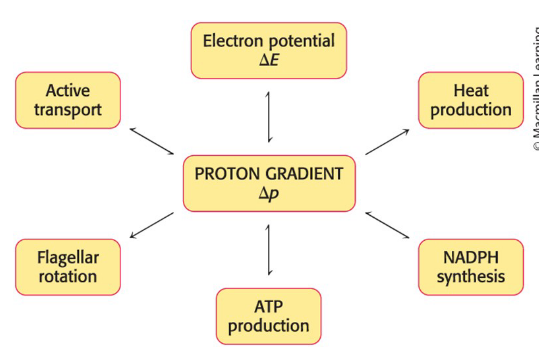Chapter 18- Oxidative Phosphorylation
1/55
There's no tags or description
Looks like no tags are added yet.
Name | Mastery | Learn | Test | Matching | Spaced |
|---|
No study sessions yet.
56 Terms
Cellular respiration
Drives ATP formation by transferring electrons to molecular oxygen
Respiratory chain (electron transport chain)
Four large protein complexes that are embedded in the inner mitochondrial membrane
Oxidative phosphorylation
Set of electron-transfer reactions that captures the energy of high-energy electrons from NADH and FADH2
takes place in the electron transport chain
ultimately generates ATP and reduces oxygen to water
cellular respiration
cellular respiration
The generation of high-transfer potential electrons by the citric acid cycle, their flow through the respiratory chain, and the accompanying synthesis of ATP
Coupling of electron carrier oxidation and ADP phosphorylation
The flow of electrons from reduced carriers such as NADH is highly exergonic
NADH + 1/2O2 + H+ → H2O + NAD+
Favorable
complexes of the electron-transport chain use released energy to pump protons out of the mitochondrial matrix
generates a pH gradient and a transmembrane electron potential that creates a proton-motive force that is used to power the synthesis of ATP
ADP + Pi + H+ → ATP + H2O
unfavorable
Mitochondria structure
The citric acid cycle, the electron-transport chain, and ATP synthesis occur in the mitochondria.
Mitochondria have two membranes (which creates two distinct internal compartments)
an outer membrane with porins
an extensive, highly folded inner membrane
intermembrane space (IM space) = compartment between the outer and inner membranes
matrix = compartment bounded by the inner membrane
Where do most citric acid and fatty acid oxidation reactions take place?
Mitochondrial matrix
Where does Oxidative phosphorylation take place?
Inner mitochondrial membrane
Membranes of mitochondria
The outer mitochondrial membrane is permeable to most small molecules and ions.
because of the presence of mitochondrial porin (voltage- dependent anion channel)
The inner membrane is folded into structures called cristae that increase the surface area to create more sites for oxidative phosphorylation.
impermeable to most ions and polar molecules
transporters shuttle metabolites across the membrane
has two sides: the matrix side and the cytoplasmic side
What does the respiratory chain consist of?
Four complexes: three proton pumps and a physical link to the citric acid cycle
electrons flow from NADH to O2 through three protein complexes embedded in the inner mitochondria membrane
NADH-Q oxidoreductase (Complex I)
Q-cytochrome c oxidoreductase (Complex III)
cytochrome c oxidase (Complex IV)
electron flow through complexes I, III, and IV is highly exergonic and power generation of a proton gradient
Complex I, III, and IV are proton pumps
Complex II
Succinate Q-reductase (Complex II) contains succinate dehydrogenase from the citric acid cycle
electrons from this FADH2 enter the electron-transport chain at Q-cytochrome c oxidoreductase
It does not pump protons
Pathway of electrons through the complexes
Complexes I, III, and IV appear to be associated in a supramolecular complex
facilitates the rapid transfer of substrate
Prevents the release of reaction intermediates
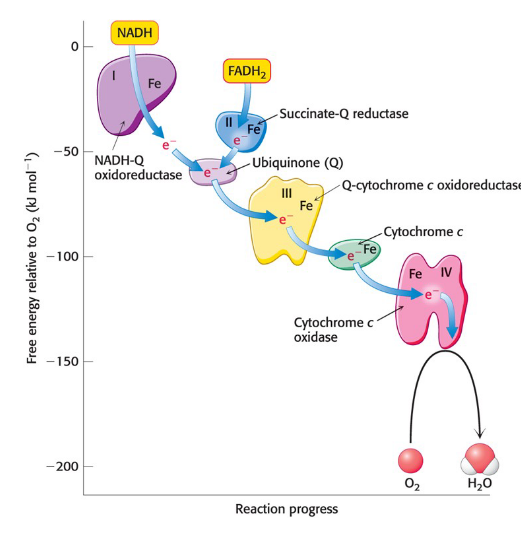
Coenzyme Q
hydrophobic quinone that diffuses rapidly within the inner mitochondrial membrane
can exist in several oxidation states
couple electron-transfer reactions to proton binding and release
functions as an electron carriers
the reduced form carries electrons from Complex I to Complex III
It transfers electrons from FADH2 from the citric acid cycle to Complex III
Cytochrome c
small soluble protein that is loosely associated with the inner mitochondrial membrane
shuttles electrons from Complex III to Complex IV
present in all organisms with mitochondrial respiratory chains
highly conserved across species
cytochrome c from any eukaryotic species will react in vitro with the cytochrome c oxidase from any other species
cytochromes
electron-transferring proteins that contain a heme prosthetic group
Iron-sulfur clusters
common components of the electron-transport chain
They are in every complex and transfer electrons
NADH-Q oxidoreductase (Complex I)
Proton pump that serves as the entry point for electrons from NADH
encoded by genes in the mitochondria and nucleus
Complex I catalyzes the reaction:
NADH + Q + 5H+ → NAD+ + QH2 + 4H+intermediate space
high potential electrons of NADH enter the respiratory chain at NADH-Q oxidoreductase
How many oxidation states does flavin have?
Two
NADH binds and the transfer of its two high-potential electrons to the flavin mononucleotide (FMN) prosthetic group of Complex I
yields the reduced form, FMNH2
electrons are then passed to a series of iron-sulfur proteins clusters in Complex I
Q Chamber
enclosed site where Q accepts electrons from NADH
Electron transfer through NADH-Q Oxidoreductase is coupled to…
Proton transfer reactions
How does structural cooperation pump protons out of the matrix?
Q accepts two electrons from NADH, generating Q2-
Q2- negative charge causes a conformational change in LH and βH elements, leading to a change in the structures of the connected vertical helices that change the pKa of the amino acids
H+ from the matrix binds to amino acids, dissociates into a water-lined channel, and enters the intermembrane space.
The flow of two electrons from NADH to coenzyme Q through Complex I leads to the pumping of 4 H+ out of the matrix of the mitochondrion.
Reduction of Q2- to QH2
Q2- takes up two protons from the matrix as it is reduced to QH2
contributes to the formation
QH2 subsequently leaves the enzyme for the Q pool, allowing another reaction cycle to occur
Succinate Q-reductase (Complex II)
Integral membrane protein complex of the inner mitochondrial membrane
contains succinate dehydrogenase
does not pump protons, reusltin in less ATP being formed in the oxidation of FADH2 than NADH
What is the entry point for electrons from FADH2 of flavoproteins
Ubiquinol
Complex II
Electrons from FADH2 (generated in the citric acid cycle) are transferred to Fe-S Centers and then to Q to form QH2
Electon flow from ubiquinol to cyctochrome c through Q-cytochrome c oxidoreductase
electrons from QH2 are passed to cytochrome c (Cyt c) by Q-cytochrome c oxidoreductase (Complex III)
leads to the net transport of 2 H+ to the intermembrane space
QH2 + 2 Cyt cox + 2H+matrix → Q + 2 Cyt cred + 4H+intermembrane space
Complex II contains:
two types of cytochromes names b and c1
four prosthetic group: three hemes and a 2F3-2S cluster
cytochrome c oxidase (Complex IV)
Catalyzes the transfer of four electrons from four reduced molecules of cytochrome c to O2
How does cytochrome c oxidase catalyze the reduction of molecular oxygen to water?
Four H+ are used to reduce O2 to H2O.
Four H+ are pumped into the intermembrane space.
∆G°′ captured in the form of a proton gradient for ATP synthesis

Steps of Cytochrome c catalyzing reaction to reduce oxygen to water
Step 1: electrons from two reduced cytochrome c molecules flow to CuA/CuA, to heme a, to heme a3, to CuB
one stops at heme a3
one stops at CuB
Step 2: reduced heme a3 and CuB bind O2, forming a peroxide bridge between them
Step 3: electrons from two more cytochrome c molecules and H+ from the matrix bind to each oxygen, cleaving the peroxide bridge
Step 4: reactions with two more H+ releases two molecules of H2O and resets the enzyme
Mechanism of cytochrome c oxidase prevents early oxygen release
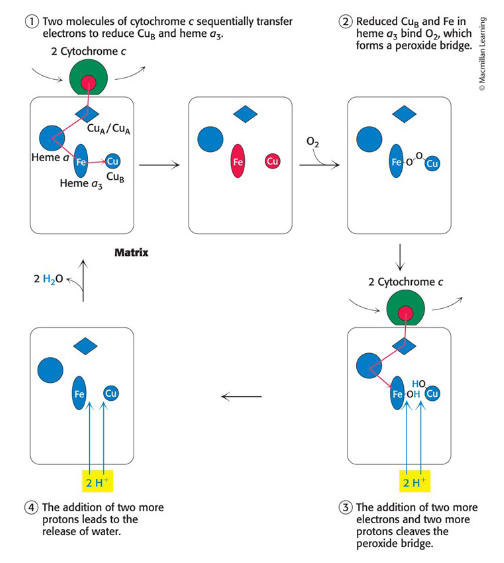
Two components of proton transport by cytochromse c oxidase
Four chemical protons reduce O2 to two H2O.
Cytochrome c oxidase uses free energy from this reduction to pump 4 H+ from the matrix into the intermembrane space
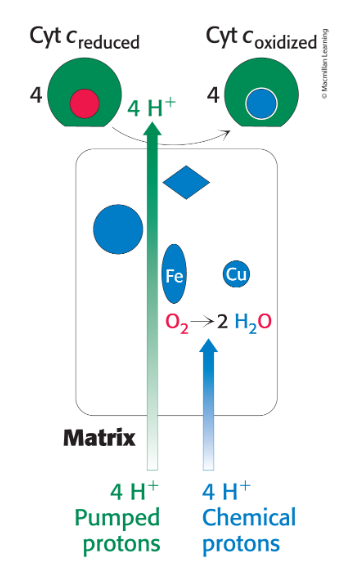
Electrons flow via two pathways through the electron-transport chain
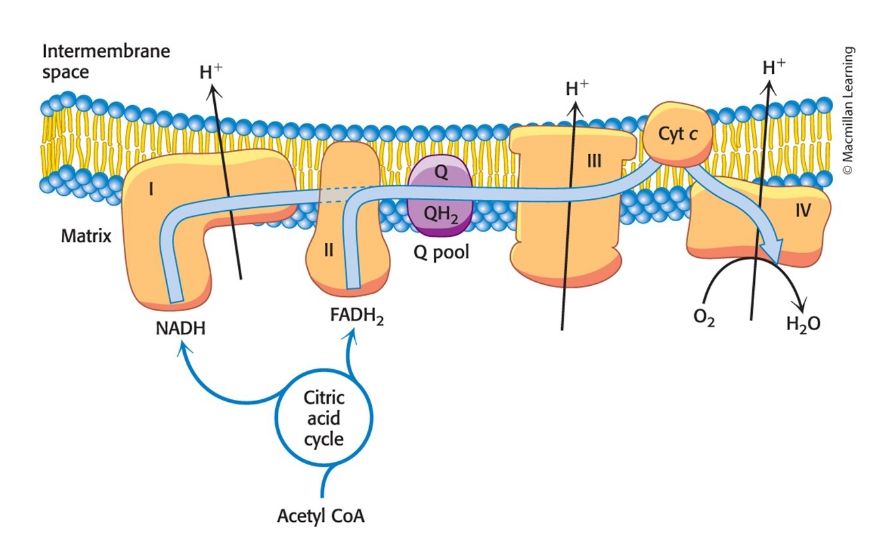
Respirasome
A massive complex in humans consisting of two copies of Complex I, Complex III, and Complex IV
Structure allows for Complex II to associate in a gaph between Complexes I and IV
enhances efficiency
Most of the electron-transport chain is organized into the respirasome
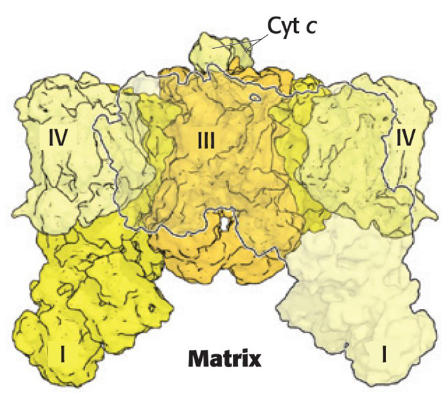
How are toxic reactive oxygen species limited in the mitochondria?
scavenged by protective enzymes
partial reduction of O2 generates highly reactive oxygen derivatives called reactive oxygen species (ROS)
ROS are implicated in aging and a growing list of diseases
ROS include superoxide ion, peroxide ion, and hydroxyl radical
cytochome c oxidase does not release ROS by holding O2 tightly between Fe and Cu ions
Superoxide dismutase (SOD) = enzyme that scavenges superoxide racidals by catalyzing the conversion of two radical into hydrogen peroxide and molecular oxygen
Eukaryotes contain two forms of SOD:
a manganese-containg version located in mitochondria
a copper-and-zinc-dependent cytoplasmic form
exercise is associated with increased SOD expression
Two phases of superoxide dismutase mechanism
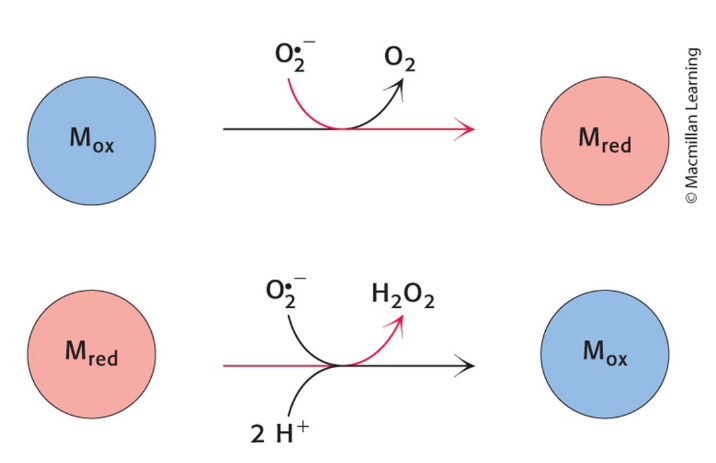
Catalase
A ubiquitous heme protein that catalyzes the dismutation of hydrogen peroxide into water and molecular oxygen

What powers the synthesis of ATP?
A proton gradient
flow of NADH to O2 is an exergonic process
Synthesis of ATP is an endergonic process
ATP synthase (Complex V)
A molecular assembly in the inner mitochondrial membrane that carries out the synthesis of ATP
Chemiosmotic hypothesis
Proposes that electron transport and ATP syntheis are ciupled by a proton gradient across the inner mitochondrial membrane
suggested that ATP ormation is powered by a proton gradient
Proton-Motive Force
The energy-rich unequal distribution of protons across a membrane
consists of a chemical gradient and a change gradient
powers the synthesis of ATP
proton-motive force (delta p) = chemical gradient (delta pH) + charge gradient
ATP synthase composition
Composed of a proton-conducting unit and a catalytic unit
Made up of two components resembling a ball on a stick:
The F0 (stick) component is embedded in the inner mitochondrial membrane and contains the proton channel
The F1 (ball) component protrudes into the mitochondrial matrix and contains the catalytic activity
Mitochondria ATP synthase forms homodimers
stabilizes the individual enzymes to the rotational forces required for catalysis
Facilitates the survature of the inner mitochondrial membrane
How does ATP Synthase assist in the formation of cristae?
Cristae formation allows proton pumps to localize the proton gradient in the civinity of the synthases, which are located at the tips of the cristae
enhances efficiency of ATP synthesis
Proton flow through ATP synthase
leads to the release of tightly bound ATP via the binding-change mechanism
ATP synthase catalyzes the formation of ATP from ADP and Pi
Actual substrates are ATP and ADP complexed with Mg2+
A terminal oxygen atom of ADP attacks the phosphorus atom of Pi
form a pentacovalent intermediate that dissociates into ATP and H2O
allows for the release of the newly symthesized ATP
the F1 subunit of the ATPase contains three β subunits
There are three active sites on the enzyme
Binding-change mechanism states a β subunit can
perform three sequential steps in ATP synthesis by
changing conformation:Step 1: ADP and Pi binding
Step 2: ATP synthesis
Step 3: ATP release
What is the ATP yield from each complete turn of the motor?
Each 360-degree rotation of the γ subunit leads to the synthesis and release of three molecules of ATP.
protons must travel around the c Ring to Cross the membrane
Oxidative phosphorylation overview
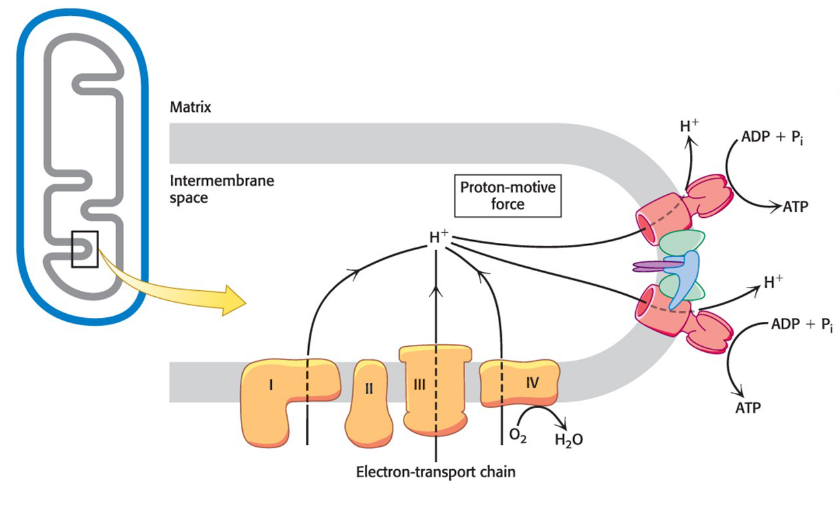
How does NADH shuttle its protons to the mitochondria?
The respiratory chain regenerates NAD+ for use in glycolysis, but the inner mitochondrial membrane is impermeable to NADH and NAD+.
glycerol 3-phosphate shuttle = one means of transporting electrons from NADH into the electron transport chain
When cytoplasmic NADH transported by this shuttle is oxidized by the respiratory chain, 1.5 ATP are formed
because FAD rather than NAD+ is the electron acceptor
Glycerol 3-phosphate shuttle steps
Step 1: Electrons from NADH are transferred to dihydroxyacetone phosphate to form glycerol 3-phosphate.
Step 2: Glycerol 3-phosphate is moved into the mitochondrion and reoxidized to dihydroxyacetone phosphate.
Electrons pass to an FAD prosthetic group, forming FADH2.
Step 3: Reduced flavin transfers its electrons to a molecule of Q, which enters the respiratory chain as QH2.
Allows for rapid rates for oxidative phosphorylation at the cost of energetic efficiency
malate-aspartate shuttle
Transports electrons from cytoplasmic NADH into mitochondria
forms mitochondrial NADH
in the heart and liver
mediated by two membrane carriers and four enzymes
Preserves all the chemical potential energy of cytoplasmically generated NADH
Malate-aspartate shuttle steps
Step 1: Electrons are transferred from NADH in the cytoplasm to oxaloacetate, forming malate and NAD+.
Step 2: malate traverses the inner mitochondrial membrane in exchange for α-ketoglutarate.
Step 3: In the matrix, malate is then reoxidized by NAD+, forming oxaloacetate and NADH to form NADH
Step 4: Glutamate donates an amino group to oxaloacetate, forming aspartate and α-ketoglutarate.
Step 5: Aspartate and α-ketoglutarate enter the cytoplasm.
Step 6: In the cytoplasm, oxaloacetate is regenerated, and the cycle is restarted.
ATP-ADP translocase (adenine nucleotide translocase, ANT)
Specific transport protein that enables the exchange of cytoplasmic ADP for mitochondrial ATP
constitutes 15% of the protein of the inner mitochondrial membrane
ATP and ADP bind to ANT without Mg2+
Inhibition of ANT leads to the inhibition of cellular respiration
Entry of ADP into mitochondria is coupled to the exit of ATP by ATP-ADP translocase
ATP-ADP translocase catalyzes the exchange of entry of ADP and ATP
the translocase contains a single nucleotide-binding site that alternately faces the matrix and the cytoplasmic sides of the membrane
Phosphate Carrier
Mediates the exchange of cytoplasmic H2PO4- for mitochondrial OH-
Works in concert with ANT to exchange cytoplasmic ADP and Pi for matrix ATP
ATP synthasome
a large complex composed of ATP synthase and the two transporters
Regulation of cellular respiration
The ATP needs of the cell determine the rate of the respiratory pathways and their components
Approximately 30 molecules of ATP formed when glucose is completely oxidized to CO2
26 are formed in oxidative phosphorylation
2 are formed in the citric acid cycle
2 are formed in glycolysis
Electrons do not flow through the electron-transport
chain unless ADP is available to be converted into ATPThe regulation of the rate of oxidative phosphorylation by ADP level is called respiratory (or acceptor) control.
At low ADP levels:
NADH and FADH2 are not consumed by the electron- transport chain.
the citric acid cycle slows because there is less NAD+ and FAD to feed the cycle.
Regulation of ATP synthase
inhibitory factor 1 (IF1) = an evolutionarily conserved mitochondrial protein that specifically inhibits the potential hydrolytic activity of ATP synthase
dimerizes when matrix pH decreases
dimers bind tightly to ATP synthase dimers, preventing the β subunits from changing conformation
essential in cases where tissues may be O2 deprived (e.g., stroke or heart attack) and the electron-transport chain cannot generate the proton-motive force
Regulated uncoupling
Leads to the generation of heat
nonshivering thermogenesis = the ability to generate heat without using shivering by uncoupling oxidative phosphorylation from ATP synthesis
occurs in mitochondria-rich brown adipose tissue in animals
activated in response to a drop in the core body temperature
uncoupling protein 1 (UCP-1; also called thermogenin) = an inner mitochondria membrane protein that transports protons from the intermembrane space to the matrix with the assistance of fatty acids
generates heat by transporting protons without the synthesis of ATP
energy of the proton gradient, normally captured as ATP is released as heat as the protons flow through UCP-1 to the mitochondrial matrix
UCP-2= uncoupling protein found in a wide variety of
tissuesUCP-3 = uncoupling protein found in skeletal muscle and
brown fatUCP-2 and UCP-3:
share >50% identity with UCP-1
may play a role in energy homeostasis
may be important in regulating body weight
Obesity leads to a decrease in brown adipose tissue.
Power transmission by proton gradients
central motif of bioenergetics
Proton gradients power a variety of energy-requiring processes
Proton gradients are a central interconvertible currency of free energy in biological systems
